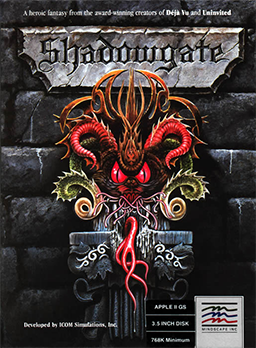Shadowgate
| Shadowgate | |
|---|---|

Cover art used in the Amiga, Apple II, Atari ST, DOS and Macintosh versions
|
|
| Developer(s) | ICOM Simulations, Inc. |
| Publisher(s) |
|
| Director(s) | |
| Composer(s) | Hiroyuki Masuno (NES) |
| Engine | MacVenture |
| Platform(s) | |
| Release | |
| Genre(s) | |
| Mode(s) | Single-player |
| Aggregate score | |
|---|---|
| Aggregator | Score |
| GameRankings | 67.14% (GBC) |
| Review scores | |
| Publication | Score |
| AllGame |
|
| GameSpot | 5.8 out of 10 (GBC) |
| IGN | 6 out of 10 (GBC) |
| Nintendo Power | 7.3 out of 10 (GBC) |
Shadowgate is a 1987 point-and-click adventure video game originally for the Apple Macintosh in the MacVenture series. It was also ported to various other systems. The game is named for its setting, Castle Shadowgate, residence of the evil Warlock Lord. The player, as the "last of a great line of hero-kings" is charged with the task of saving the world by defeating the Warlock Lord, who is attempting to summon up the demon Behemoth out of Hell.
The player must solve a series of puzzles throughout the castle to proceed to the Warlock Lord's chamber. Due to the castle's perilous nature, at least one lit torch must be in the player's possession at all times. If the torch is extinguished, the player soon stumbles, breaking his neck, and must then continue from a saved game (or the area in which they died, in game console versions). Only a finite number of torches are to be found throughout the game, which effectively acts as a time limit to proceedings. Various items that can be acquired include sword, sling and other ancient weapons; though these weapons can not actually be used as striking weapons, they can be clicked on at the appropriate time to deliver a fatal blow to specific enemies.
The game is notorious for its many opportunities for death, including being burned by a dragon's breath, attacked by a cyclops, sucked into outer space through a broken mirror, dissolved by acidic slime, mauled by a wolf-woman, eaten by sharks, and suicide. Virtually any action taken by the player which is not the correct solution to a puzzle will result in a fatality. These deaths were often graphically described in the game's text (along with often sardonic and humorous comments), even in the NES version (in spite of Nintendo's policy of censorship at the time). Many of the game's puzzles rely on a system of trial and error, the problem of which is overcome by the ability to save the game state (as in most adventure games). Subtle hints can be found in books and the descriptive game texts. In the NES version, these are replaced by an outright hint feature which gives vague clues about what is noteworthy in any given room in the castle. The further the player progresses, however, the more useless this feature becomes, deteriorating into nothing but encouraging messages by the game's end. The NES version of Shadowgate also carries the distinction of being one of the few NES games to be available in a Swedish language version.
...
Wikipedia
